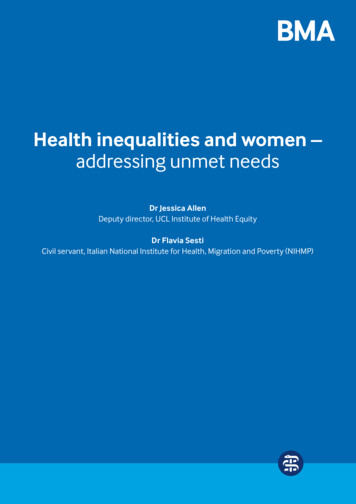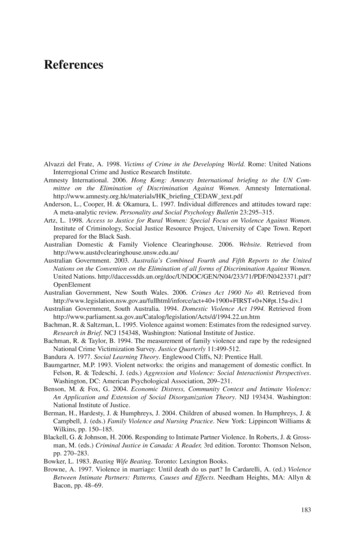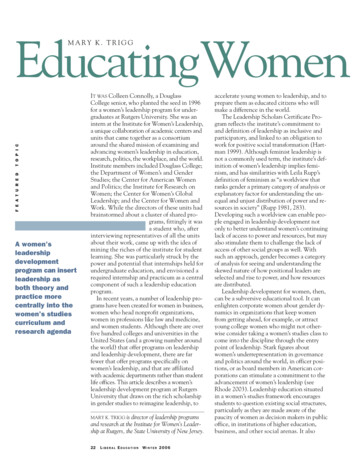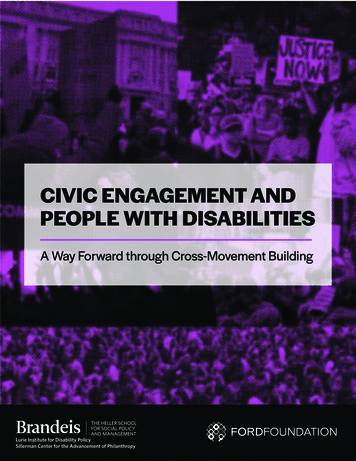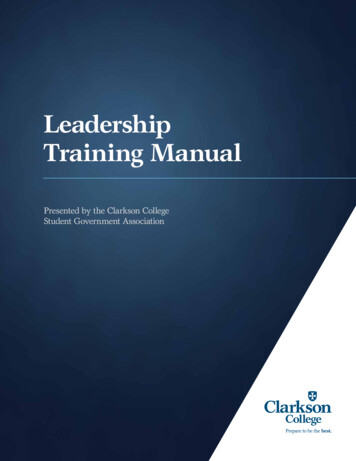
Transcription
Leadership: Underrepresentation of Womenin Higher EducationDissertation ManuscriptSubmitted to Northcentral UniversitySchool of Educationin Partial Fulfillment of theRequirements for the Degree ofDOCTOR OF PHILOSOPHYbySusan Faye KrauseSan Diego, CaliforniaJanuary 2017
ProQuest Number: 10259477 All rights reserved INFORMATION TO ALL USERSThe quality of this reproduction is dependent upon the quality of the copy submitted.In the unlikely event that the author did not send a complete manuscriptand there are missing pages, these will be noted. Also, if material had to be removed,a note will indicate the deletion. ProQuest 10259477Published by ProQuest LLC (2017 ). Copyright of the Dissertation is held by the Author. All rights reserved.This work is protected against unauthorized copying under Title 17, United States CodeMicroform Edition ProQuest LLC. ProQuest LLC.789 East Eisenhower ParkwayP.O. Box 1346Ann Arbor, MI 48106 - 1346
Approval PageLeadership: Underrepresentation of Womenin Higher EducationBySusan Faye KrauseApproved by:3/13/17Chair: Melanie Shaw, Ph.D.DateCertified by:3/13/2017Dean of School: Rebecca Wardlow, Ed.D.Dateii
AbstractIn 2014, statisticians at the Bureau of Labor Statistics found that womenconstitute 45% of the workforce. Women’s participation in high-levelorganizational leadership roles remains low. In higher education, women’srepresentation in top-ranking leadership roles is less than one-third at colleges anduniversities. The conceptual framework for this study was the role congruitytheory of prejudice toward female leaders. The specific problem is howstereotypical views of female behavior affect women who aspire to high-rankingleadership roles in higher education. This was a qualitative study using a multiplecase study methodology. The study was organized by research questions thatreflected on the underrepresentation of women leadership roles in highereducation. Members of Arizona Women in Higher Education were invited toparticipate in interviews regarding their experiences as a woman in leadership.The interview questions consisted of open-ended questions that explored thedefinitions of leadership, leadership styles, how these definitions influenced theirworkplace behavior, and the experiences of these women in their leadership roles.The findings of this study did not fully support that the lack of women inleadership positions in higher education is due to a bias toward their role as afemale when serving in the position of a traditionally defined masculine role ofleadership. The conclusion is that stereotypical views of female behavior had littleimpact on the successful careers of the participants. The participants gave littlesignificance to experiences with social role expectations or to the definitionssociety have given to the definition and characteristics of leadership. Theiii
participants’ perception of their success was due to merit; the recognition byothers as having the qualities and skills to lead in a variety of positions. Furtherqualitative research with male leaders as participants would provide a comparisonbetween male and female gender roles and how those roles are influenced bysociety’s expectations. Additional research using a mixed methodology mayprovide a broader range of understanding of women’s experiences with thestereotyping of female behavior through the combining of quantitative andqualitative data analysis, as the qualitative data can enhance the interpretation ofthe quantitative data collected.iv
AcknowledgementsOne cannot accomplish the completion of a dissertation alone. An intricatesupport system is required. I want to acknowledge my support system; from myacademic advisor, faculty, chair, and committee members for the timely andrelevant feedback I received during the process. I want to acknowledge my fellowstudents and work colleagues; Ramon, Barbara, and Dara for their unwaveringencouragement. I cannot place a value on the support and encouragement Ireceived from Dr. Jeannette Lovern. Thank you, Jeanette for being my guide andinspiration. However, there is one person who has given me unlimited supportthroughout this journey and that person is my beloved husband of 46 years. Thankyou Paul, always and forever, for being my sounding board, my confessor, mytherapist, and my best friend. The ring has been cast into the fire; it is done.v
Table of ContentsChapter 1: Introduction . 1Background . 2Statement of the Problem . 3Purpose of the Study . 4Conceptual Framework . 6Research Questions . 9Nature of the Study . 9Significance of the Study . 11Definition of Key Terms . 11Summary . 12Chapter 2: Literature Review . 14Documentation . 14Role Congruity Theory of Prejudice towards Female Leaders . 15Leadership Theory . 21Gender, Leadership, and Bias . 25Gender Stereotyping in the Workplace . 31Women in the Workforce. 33Barriers to Female Leadership . 35Women in Higher Education . 42Barriers Inside Higher Education. 45Summary . 50Chapter 3: Research Method . 52Research Methods and Design(s). 55Population . 59Sample. 60Materials/Instruments . 62Data Collection, Processing, and Analysis . 63Assumptions. 65Limitations . 65Delimitations . 66Ethical Assurances . 66Summary . 67Chapter 4: Findings . 69Trustworthiness of Data . 69Results . 72vi
Evaluation of Findings . 81Summary . 83Chapter 5: Implications, Recommendations, and Conclusions . 81Implications. 84Recommendations . 89Conclusions . 91References . 93Appendixes . 103Appendix A . 104Interview Questions . 104Appendix B . 105Informed Consent. 105vii
1Chapter 1: IntroductionWomen have made advances toward equality in both the social environment andin the workplace since the 1960s. According to statisticians at the United States Bureauof Labor Statistics, women constitute 45% of the workforce, and yet their participation inhigh-level organizational leadership roles remains low (BLS, 2015; Cook & Glass, 2014;Eagly, 2007; Madden, 2011). In higher education, women’s representation in top-rankingleadership roles is less than one-third at colleges and universities (Cook, 2011; Gallant,2014). The low representation of women in high-level leadership roles has led to aninference that there may be a hidden prejudice toward women seeking positions ofleadership.Researchers indicated that even though women attending college and obtaining amajority of undergraduate, graduate, and doctoral degrees, they (women) remainunderrepresented in the top leadership positions in higher education institutions(DeFrank-Cole, Latimer, Reed, & Wheatly, 2014; Gallant, 2014; Longman & Anderson,2011). Since 1986, statisticians at the American Council on Education (ACE) havecollected data on American college presidents. The researchers reported that women inthe office of presidency in higher education stand at 26.4% and has slowed down fromthe 50% growth rate experienced in the 1990s (Cook, 2011). The ACE data offers noexplanation for the slower growth rate. Cook’s (2011) research indicated that womenappear to follow a traditional career path toward top academic positions. They becomewell-known as faculty and scholars within higher education. Men who rise to toppositions are likely to come from other businesses, politics, or military, or even a nonacademic position on campus. Cook suggested there is a sexist strategy at work; men are
2hired for their potential and women are hired based on their achievements.BackgroundResearchers reported that in practice leadership characteristics of women and menare virtually indistinguishable (Kosicek, Soni, Sandbothe, & Slack, 2012). Although,women exhibited characteristics leading to effective performance more often than mendid; the stereotypical view of women in the workforce puts focus on feminine attributesor gender roles rather than leadership style (Braun, Peus, & Frey, 2012). A comparativestudy investigated leadership styles of administrators in community colleges. Theresearchers reported stereotypical viewpoints of male and female leadership with maleleadership being directive and autocratic, while female leadership being merit-based andparticipatory (Eddy & VanDerLinden, 2006). According to Madden (2011) male orfemale stereotyping has a pervasive effect on not just how others view women inleadership roles, but how women view themselves in situations where leadership isrequired, influencing all aspects of men and women’s behavior.Women in higher education remain underrepresented consistently at the executivelevels of leadership in the positions of dean, provost, and president (Gallant, 2014). Thereare a number of reasons identified by researchers for the persistence of theunderrepresentation of women in the top ranks of leadership. Women frequently listedgender role stereotypes, lack of female role models, and childcare or domestic duties asobstacles they faced when seeking top roles as leaders (Cook & Glass, 2014; Ely, Ibarra,& Kolb, 2011; Gallant, 2011). However, organizational policies, practices, and processescontinually perpetuate inequality and prejudice leading to the glass ceiling effect, theivory basement, and velvet ghetto situations preventing women from obtaining executive
3leadership roles (DeFrank-Cole et al., 2014). DeFrank-Cole et al. (2014) reported thesemetaphors are used to describe the invisible ceiling women hit when pursuing leadershippositons at the senior-most levels even though they have succeeded through their careers.These images describe the practices and policies in both the corporate world and highereducation institutions that relate specifically to the obstacles women face as they aspire toleadership positions.Statement of the ProblemThere is a gender gap in leadership roles in institutions of higher education (Chin,2011, Cook, 2012; DeFrank-Cole et al., 2014). There is no doubt that women have madeadvancements toward gender equality in the workplace where they constitute 46% of thelabor force (Chin, 2011; Pfaff, Boatwright, Potthoff, Finan, Ulrey, & Huber, 2013; BLS,2015). However, women have not made the same advancements in corporate leadershiproles (Cook & Glass, 2014, Madden, 2011). Furthermore, in higher education women areconsistently underrepresented in the top ranks of leadership even though they earn morebachelor’s, master’s, and doctorate degrees than men (DeFrank-Cole et al., 2014; Diehl,2015; Gallant, 2014; Lennon, Spotts, & Mitchell, 2013). The data collected on Americancollege presidents by ACE indicated women achieving the role of presidency in highereducation institutions nearly doubled from 9.5% in 1986 to 19.3% 1998 (as cited inCook, 2012). However, between the years 2006 and 2011 the number of women whohave achieved the presidency at a higher education institution has slowed to a 15%growth rate. If the growth continued at the 1998 rate, women representing collegepresidents would be approaching 50% instead of the 26.4% reported in 2011 (Cook,2012). The reason for the slowing of the rate of women obtaining the position of the
4presidency is unknown (Chin, 2011; Cook, 2012; Cook & Glass, 2014). A review of theliterature on the lack of women representation in high-level leadership positions revealedthat the role congruity theory of prejudice toward female leaders introduced by Eagly andKarau (2002) might provide one possible explanation for the phenomenon of theunderrepresentation of women in leadership in higher education. There is a conflictbetween leadership roles and prescriptive expectations for women’s behavior. Thisconflict leads to prejudicial judgments and actions. This bias toward female leadershipaverts the promotion of women leadership positions (DeFrank-Cole et al., 2014). Thecommon theme in leadership studies that good leadership is inconsistent with femalebehavior presents the opportunity to perform further research on bias toward femalebehavior in leadership in the field of higher education (Chin, 2011; Cook & Glass, 2014;Madden, 2011). The specific problem is how do stereotypical views of female behavioraffect women who aspire to high-ranking leadership roles in higher education.Purpose of the StudyThe purpose of this multi-case qualitative study was to explore how stereotypicalviews of female behavior affect women who aspire to high-ranking leadership roles inhigher education. Gaining new knowledge about women’s experiences with gender biasand role stereotyping may benefit future generations of women aspiring to organizationalleadership roles. The focus of the study was to examine individual experiences of womenwho currently perform or have performed in these roles at colleges and universities in theState of Arizona. I explored the problem by using a semi structured interview approachthat allowed me to use prepared questions. Researchers, such as Cohen & Crabtree(2006) and Yin (2014) suggested this approach allows for a conversational nature to
5interviews and provides the participants the freedom to express their views in their ownterms.The story-telling aspect of women’s experiences in obtaining leadership roles andthe interpretation by the interviewer endorsed the narrative analysis as a relevant methodfor exploring the difficulties women face along their career path in higher education(Sands, as cited in Padgett, 2004). Looking for the complexities in the viewpoints ofwomen who are currently performing or have performed leadership roles at colleges anduniversities in the United States in the state of in Arizona, I invited members of ArizonaWomen in Higher Education (AWHE) to participate with me in interviews. I wanted tolearn more about their experiences with stereotypical views of female behavior as theyaspired to leadership roles in higher education.Open-ended questions allowed the participants to describe their experiencesthrough any changes in how they viewed themselves as women and as leaders and what,if any significance they gave to experiences with stereotyping of their behavior as theysought leadership positions. Additionally, recounting their experiences with stereotypingincluded stories on any change in behavior they made to avoid future experiences withstereotyping. A comparison of the data collected from the individual case studiesprovided ample context for triangulation and data saturation as patterns were found in theconsistent similarities of the stories told. This research adds to the body of knowledgeregarding stereotypical views of female behavior and its effect on women who aspire tohigh-ranking leadership roles in higher education.
6Conceptual FrameworkThe role congruity theory of prejudice toward female leaders proposed by Eaglyand Karau (2002) states that if a woman, as a leader, exhibits masculinity, she will beseen less favorably as a leader because the behavior is inconsistent with the femalegender as assigned by society (Eagly & Karau, 2002). I used the role congruity theory ofprejudice toward female leaders to provide perspective on the persistence of gender rolestereotyping of women in leadership roles in the field of higher education. Eagly andKarau (2002) proffered that bias in favor of masculine leadership styles makes it difficultfor women to be selected for leadership roles; and once they do, their behavior as leadersis regularly assessed in a less than positive view. According to Eagly & Karau (2002), therole congruity theory of prejudice toward female leaders holds there is a contradictionbetween leadership roles and prescriptive expectations for women’s behavior that leads toprejudicial judgments and actions. DeFrank-Cole et al. (2014) asserted this bias makes itdifficult for women to be selected for leadership roles and to achieve success in theirperformance as leaders once they do.Researchers of organization leadership noted that strong leadership is associatedwith a masculine gender role of assertiveness, confidence, and control (Johnson, Murphy,Zewdie & Reichard, 2008). Madden (2011) explained that most leadership definitionsdescribe the characteristics of leadership in agentic or masculine terms. Agenticcharacteristics are assertiveness, controlling behaviors, ambition, and aggressiveness.Definitions of leadership began to merge around the 19th century idea of the great mantheory and its effect on how society views leadership traits (Heifetz, 1994 as cited inEddy & VanDerLinden, 2006). Madden further described communal characteristics as
7opposites to agentic ones. Furthermore, Madden associated communal traits withfeminine roles because the traits are described as nurturing, warm, friendly, and sensitive.Johnson et al. (2008) further asserted that people, as individuals have expectationsfor how men and women should behave. Individuals take these behavioral expectationsinto their work life and their beliefs in how leaders should behave. Therefore, when theperson in charge behaves consistently with an expectation of what leadership is, then thatperson is perceived as an effective leader (Johnson et al., 2008). Researchers ofleadership definitions and gender stereotyping in higher education, such as Eddy &VanDerLinden (2006), Gallant, (2014), and Madden (2011) reported that whensubordinates define leadership as masculine and a woman displays an agentic trait; herbehavior is incompatible with her female gender role of being warm and nurturing. Thisincongruity in behavior makes it difficult for people to perceive or even accept a womanin a leadership roleThere are theories worthy of consideration when contemplating the reasons whywomen do not have a greater presence in high-level leadership positions. Concepts suchas social role theory (Eagly, 1987), Eagly and Karau’s (2002) role congruity theory ofprejudice toward female leader, and leadership theory (McCleskey, 2014) proposed thatthe definition of leadership presents a bias in favor of men as leaders and unfavorablytoward women as leaders (Eagly, 2002; McCleskey, 2014; Miller, 2013). From thesetheories it can be gleaned that stereotyping and bias toward the female gender evensubliminal may be one reason for the low representation of women in executiveleadership positions across all industries.
8Role congruity theory of prejudice toward female leaders is an expansion ofEagly’s 1987 research on role theory in sociologic terms (as cited in Eagly & Karau,2002). In the mid-twentieth century sociologists and psychologists studied role-play as amethod of providing patients with insight into their daily lives (Miller, 2013). A role is abroad pattern of behavior and attitude that is linked to a socially identified status, such asgender, age, or position in society (Turner, 2000). Basic roles, like those attached togender and age identities, are the most inclusive, affecting what is expected of anindividual in a wide variety of situations (Yodanis, 2003). Culturally defined norms orstandards for behavior shape one’s position in society and other statuses such as genderand influences a person’s behavior (Yodanis, 2003). The theory became the foundationfor researchers in the 1980s to explore social interaction through the roles of gender andsocial status (Miller, 2013). Researchers, such as Koenig and Eagly (2014) and Miller(2013) investigated role theory in terms of expected social roles and discovered a fixedset of expectations by society that cause men and women to behave in a predictable way.In organizational leadership, role congruity theory of prejudice toward femaleleaders magnifies the disproportion of women in organizational leadership roles byplacing the lens of prejudice on the behavior of women who aspire or have obtainedexecutive level leadership roles as a possible reason for the disparity. In higher education,women are underrepresented in the senior leadership ranks at only 24.6% in 2011 (Cook,2012; Gardner, 2013). Scholars have linked the cause for this lack of representation to anumber of reasons including gender role stereotypes and the number of women availableto fill leadership roles (DeFrank-Cole et al., 2014). However, to address of the lack ofwomen available to fill leadership roles, Lennon et al. (2013) reported that more women
9in the U.S are attending college and obtaining advanced degrees than men. Yet, thehigher number of women qualified for leadership roles do not translate into a higherrepresentation of women in leadership roles. In higher education, women who do holdexecutive leadership positions are pointedly lagging behind men in both status and salary(Lennon et al., 2013). For the purpose of this study, using role congruity theory ofprejudice toward women in leadership roles provided a conceptual framework as a lensthrough which the underrepresentation of women in higher education leadership roleswas explored.Research QuestionsThe following research questions explored women’s individual challenges withstereotypical views of female behavior as they aspired to executive leadership roles atcolleges and universities. In an effort to discover if parallels in women’s experiences withbias or prejudice as they aspired to executive leadership roles, the answers may lead to apossible reason for the underrepresentation of women leadership roles in highereducation.Q1. How do women describe the significance of their experiences with bias,stereotyping, or prejudice as they sought leadership positions in higher education?Q2. How do women define the difference between their feminine gender rolesand the leadership-style characteristics they took on in order to succeed on their careerpath to a leadership role in higher education?Nature of the StudyThis was a qualitative multi-case study with a narrative inquiry approach. Thestudy addressed the crucial issue of how stereotypical views of female behavior affect
10women who have achieved high-ranking leadership roles in higher education. Thetrustworthiness of qualitative research relies on interpreting the meanings researchparticipants give to their experiences. Yin (2014) suggested qualitative case studies forsociological phenomenon phenomena and behavioral events. Landrum and Garza (2015)concurred that affirming the exploratory nature of qualitative studies allowed researchersto attribute meaning to an individual’s experiences with a particular phenomenon.Selecting a narrative analysis design with semi-structured interview questionsallowed for the collection of data using the story-telling aspect of women’s experienceswith bias toward their female behavior in leadership roles. For the purposes of this study,a qualitative study method using anecdotal stories was more powerful than quantitativefindings and is one reason the qualitative method was selected. The stories capturedthemes in the experiences of women who have faced the stereotyping of female behavior.The story-telling aspect of a semi-structured interview was a relevant method forexploring the difficulties women face along their career path in higher education. Inqualitative data analysis processes, Chenail (2012) suggested the researcher seeks tomake an evidenced based assertion of the knowledge gained from the conversation withthe participants.While capturing language used during the interviews, an interpretive method ofdata analysis focused on the narrative value of the research participants’ stories. Chenail(2012) described qualitative data analysis as a story-telling metamorphic process. Peoplelike to tell stories and when they do, they shape their reality, both in thought and feeling,but also in their observable actions (Padgett, 2004). In narrative analysis, there is anallowance for observations of language usage as interviewees describe how events during
11their career are perceived and understood. As such, using semi-structured interviewquestions with a rhetorical approach to narrative analysis allows for the unspoken,implied understandings that lie beneath the stories the participants tell during theirinterviews (Feldman, Sköldberg, Brown, & Homer, 2004). Qualitative data analysissoftware (CAQDAS) isolated and then cross-referenced the stories using open coding ofwords and phrases and axial coding that sorted the words and phrases into themes.Significance of the StudyThe disparity between the high number of women who obtain a college degreeand the underrepresentation of women in the executive leadership roles is problematic.The discrepancy is that women are welcome to receive a higher education yet they arenot welcome to undertake leadership responsibilities in colleges and universities (Lennonet al., 2013). The significance of this study is the addition of women’s voices to explainthe reason behind the lack of representation in leadership at higher education institutions.The study contributed to the field of organizational leadership through the appraisal ofthe persistent presence of bias and stereotyping of the female gender role. The studycontributed to research on a potential reason for the disparity between highly educatedwomen and the lack of women in leadership positions in the field of higher education.Definition of Key TermsAgentic leadership characteristics. Agentic leadership characteristics areassertive, aggressive, ambitious, control and dominance. These behaviors are assigned asmasculine characteristics in leadership (Eagly, 2002; Madden, 2011).
12Bias. Bias is the collective subconscious influence an individual’s perception ofrace, ethnicity, gender, or age, can have on understanding, actions, and decision-making(Staats, 2015).Communal leadership characteristics. Communal leadership characteristics arehelpful, sensitive, nurturer and are assigned to female characteristics in leadership (Eagly,2002: Madden, 2011).Executive leadership role. In higher education, executive leadership roles referto Presidency, Chancellor, or Chief Acad
The study was organized by research questions that reflected on the underrepresentation of women leadership roles in higher education. Members of Arizona Women in Higher Education were invited to participate in interviews regarding their experiences as a woman in leadership. The interview questions consisted of open-ended questions that .



